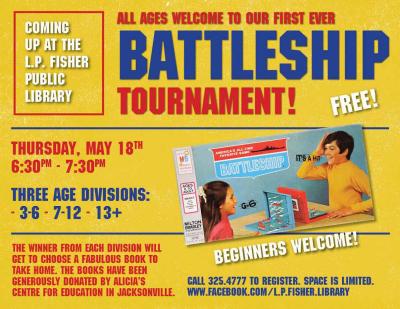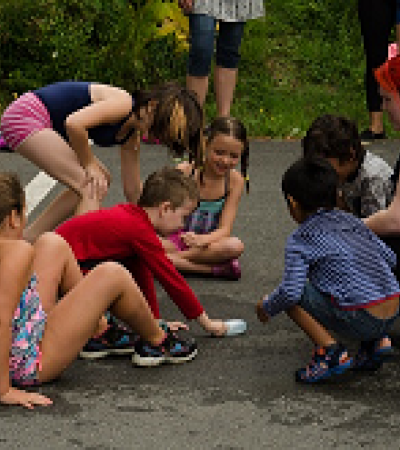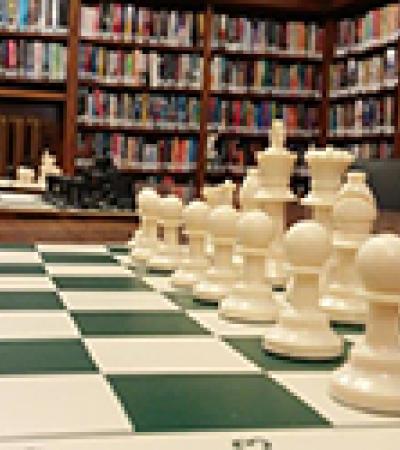The L.P. Fisher Public Library is well-known in our community (Woodstock, N.B., Canada) for our board game programs, like Connect Four Tournaments, Family Game Nights or our (competitive!) Chess Club. As a strong promoter of physical literacy, I’m always thinking of ways to incorporate more movement into our programs (beyond fine motor skills, of course!). So I came up with a life-size version of Battleship we could play with our whole bodies, inspired by a version my eldest son played in gym class.
I tried this first at the local Jiu Jitsu gym where I help lead the kids’ training sessions. It was a hit, so I knew it would work at the library. We ran the program over the March break and had more than 15 people show up. This is a nice low-cost program; the only thing you really need is a ball and some existing tables from your library.

The space
You're going to need a large room (a gym is ideal!) or a large lawn of grass away from traffic. The room or lawn needs to be divided in the middle by a barrier. The barrier needs to be tall enough to create an obstacle the participants can’t see over — but not so high they can’t throw a ball over it.
Indoors, I’ve used folding tables or crash mats (both turned on their sides). Outdoors you could string up a volleyball or badminton net close to the ground (though you’d need to find a way to make it not transparent). A large horizontal banner or length of stretchy fabric would also work, as long as you had a way to secure it on either end.
The ball
Then you need to find a ball (or if you want to play like these brave humans, many balls) that won’t hurt when it lands on someone.
Thin, squishy plastic is the best. A balloon is too lightweight, a soccer or basketball is too heavy. I used a giant bouncing ball about three feet in diameter — the kind that kids can sit on and bounce around. A dodgeball or beach ball would also work.
Remember, the smaller the ball, the harder the game is going to be and the longer it will take (depending on how many “ships” you have). Depending on the space, the equipment you have available, and the time you have to prepare, you can make this as simple or as complicated as you'd like.
The game
Divide your group into two teams, one team on each side of the barrier. Everyone lies on the ground, arms planted to their sides, just like the ships in the game. The only time they are permitted to move is when it is their turn to throw the ball.
You will act as referee and ball-chaser and will remain standing. The teams take turns throwing the ball across the barrier and trying to hit a “ship” (person) on the other side. Here’s the challenge — they have to throw the ball from their position on the floor. This is really hard work — it takes a whole lot of strong tummy muscles and concentration to throw that ball with any accuracy! No doubt, this will create a lot of giggling as the ball will fly off in many unintended directions, since throwing from a horizontal position uses the vestibular system and our sense of proprioception. Sometimes a player will think they are throwing a ball over the barrier only to find they have thrown it straight up in the air and now it is landing on their own face!
I usually allow the youngest of players to throw from a seated position so they don’t get discouraged. Also, feel free to modify or adapt the rules for players with disabilities.
Your job as referee is to declare any hits, make sure the “ships” aren’t moving to get away from the ball, and to run after the ball and bring it back into play when it goes out of bounds. A hit “ship” must leave the play area and wait off to the side. (They can also be recruited to help catch runaway balls.) The first team to blow all the other team’s “ships” out of the water wins.
Your patrons will have lots of fun playing this game; I recommend it for ages 6 and up. If you have enough room, invite whole families to join in. It would also be great for teens, or even adults as a fun activity during a professional development day!
After you play
Play as many games as you have time for. After our game finished we set up the tables and brought out the tabletop board game version of Battleship (we have many copies and versions, including Star Wars) and the kids had fun for another 45 minutes. If you don’t have the physical games but have access to a computer lab, there are many free online versions of the game including this one geared toward younger kids and this one for older kids or adults. The digital version is a great option for patrons on the autism spectrum (or introverts!) who may feel too uncomfortable playing one-on-one in person.
No matter how you to choose to play the game — have fun!



